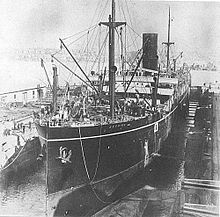Caird & Company
| Caird & Co. | |
|---|---|
| legal form | |
| founding | 1828 |
| resolution | 1935 |
| Seat | Greenock, Scotland |
| Branch | Shipbuilding |
Caird & Co. was a shipyard in Scotland Greenock . The company, which was founded in 1828, ceased operations in the 1930s.
history
The beginnings
The company was founded in 1828 as a design office and built, among other things, four locomotives for Scottish Railways in 1840/41 . James Tennant Caird spent his apprenticeship in the design office and began building ships in 1839 at the John Scott & Sons shipyard in Greenock. The first ship under Caird's leadership was Margaret, measured at around 700 GRT . Numerous paddle steamers were built during the 1840s and an order to build four ships for the Royal Mail Steam Packet Company was won . After the first ship steam engine was built in 1847, ship engines for the steam ships of the West India Mail Packet Company could already be delivered in 1852 . In the same year, a 45-ton crane was put into operation at the shipyard. The following year, the Atrato, the first iron ship was built.
Move to Westburn
In 1867 Caird left the old "Cartsdyke mid yard" and instead took over the "Westburn East" site, and in 1871 the "Westburn West yard" was also taken over. From around 1870, the Peninsular and Oriental Steam Navigation Company (P&O) became one of the shipyard's main customers, which built a total of 85 ships for P&O in the following years. The best-known German shipping companies that ordered large numbers of newbuildings in Greenock were Norddeutsche Lloyd and Hamburg-American Packetfahrt-Actien-Gesellschaft (HAPAG). Iron sailing ships and yachts were also built in the 1880s.
When James Caird died in 1888, his shipyard had completed 243 ships. His sons Patrick, William, Arthur and Robert took over the company and converted it into a Limited Company (Ltd.) on December 19 of the same year . From 1890 until the First World War , the shipyard produced 35 steel ships for P&O liner services.
During the First World War, the shipyard built a few patrol boats for the Royal Navy as well as three units of the standard war types A , five C types and another two AO tankers. At the same time some modifications and repairs were carried out. After that, there were no new construction orders to be received for some time.
Under Harland & Wolff Egide
After Robert Caird died in December 1915, the company was taken over by Harland & Wolff , with Arthur and Patrick Caird remaining as directors of the company. The company name Caird was retained until 1922.
After the end of the war, Harland and Wolff invested under the name Caird in neighboring shipyards and increased shipyard capacity. In 1919 around 2,000 workers were therefore employed. The lack of demand slowed the shipyard's expansion in the first half of the 1920s, but ships continued to be built on a significant scale during the crisis. 1926, however, the first time no ship was more even in Caird lowered into the water , followed again in 1927 four new buildings and in 1928 another ship.
Until 1935, more ships were built for various owners and the shipyard was then closed due to lack of demand and dissolved by the National Shipbuilders Security . The last two orders were the Saganaga and the Inventor . The northwest part of the former shipyard still exists today, the warehouses of which are now part of the Greenock Container Terminal .
More shipyards
- John Priestman & Company ( North East England )
- Ropner Shipbuilding ( North East England )
- William Doxford & Sons ( North East England )
Web links
- Shipyard description viewed on gracesguide.co.uk August 9, 2010
literature
- Arnold Kludas : The ships of the North German Lloyd . 1857 to 1970. Weltbild Verlag, Augsburg 1998, ISBN 3-86047-262-3 .
- Arnold Kludas: The History of German Passenger Shipping . Volume I: The pioneering years 1850 to 1890 . Ed .: Detlev Ellmers, Wolf-Dieter Hoheisl, Gert Schlechtriem. Weltbild Verlag, Augsburg 1994, ISBN 3-89350-821-X .
- H. Clarkson & Co. Ltd. (Ed.): The Clarkson Chronicle 1852-1952 . Harley Publishing, London 1952.
- Germanischer Lloyd (Ed.): International Register 1881 . Germanischer Lloyd, Berlin 1881.

